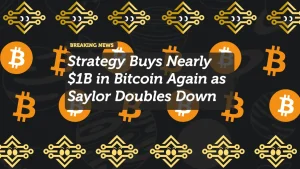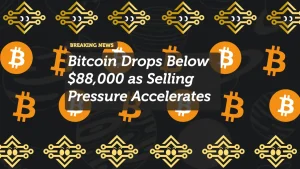
MARA Holdings Acquires $1.1B in Bitcoin, Embracing MicroStrategy’s Playbook
In a bold move reminiscent of MicroStrategy’s playbook, MARA Holdings has acquired $1.1 billion worth of Bitcoin, cementing its position as one of the most aggressive institutional Bitcoin holders in the market. Using zero-coupon convertible notes to raise funds, MARA is doubling down on a strategy popularized by Michael Saylor, who has turned Bitcoin accumulation into a financial art form.
With this acquisition, MARA is making waves in the crypto space, proving that the “Saylor Strategy” is alive and well. Let’s break down what this means for Bitcoin, MARA, and institutional adoption as a whole.
1. The Saylor Strategy: What is MARA Doing?
MARA’s Bitcoin purchase closely mirrors the strategy pioneered by MicroStrategy CEO Michael Saylor, who has transformed his company into a Bitcoin treasure chest by issuing convertible notes.
How Zero-Coupon Convertible Notes Work:
- Convertible Notes: These are bonds that can later be converted into company equity.
- Zero-Coupon Feature: Unlike traditional bonds, these notes don’t pay interest. Instead, they’re issued at a discount, making them attractive to investors.
- Why It Works for Bitcoin: Companies can raise large sums of money without immediate cash flow burdens, then use the proceeds to accumulate Bitcoin as a treasury asset.
MARA’s $1.1 Billion Investment:
- MARA has issued zero-coupon convertible notes to fund its massive Bitcoin purchase, mirroring MicroStrategy’s approach.
- This move underscores a growing trend of companies using low-cost financing to accumulate Bitcoin at scale.
Michael Saylor’s influence is clear: the strategy allows companies to leverage Bitcoin’s potential for long-term appreciation while keeping operational costs low.
2. Why MARA’s Move Matters
Institutional Confidence in Bitcoin
MARA’s purchase sends a strong message to the market: Bitcoin is no longer a speculative gamble—it’s a strategic asset for institutions.
- Hedge Against Inflation: With global inflation concerns mounting, Bitcoin’s capped supply makes it an attractive hedge against currency devaluation.
- Digital Gold Narrative: MARA’s decision reinforces Bitcoin’s position as a store of value, similar to gold but with added portability and utility.
Accelerating Institutional Adoption
- Just as MicroStrategy’s early purchases paved the way for other corporations, MARA’s move could inspire more institutions to adopt Bitcoin.
- The use of innovative financing mechanisms like convertible notes makes it easier for companies to enter the crypto space.
3. How Does This Impact Bitcoin’s Market?
Large institutional purchases like MARA’s have significant implications for Bitcoin’s price and market dynamics.
1. Increased Demand
- A $1.1 billion acquisition significantly reduces Bitcoin’s available supply, driving up demand and potentially leading to a price increase.
2. Supply Scarcity
- With a fixed supply of 21 million coins, institutional accumulation contributes to long-term scarcity, making Bitcoin more valuable over time.
3. Reduced Volatility
- Institutional holdings often act as a stabilizing force, reducing Bitcoin’s infamous volatility by introducing long-term holders to the market.
4. The MicroStrategy Influence: Saylor’s Ongoing Legacy
MARA’s move is the latest example of Michael Saylor’s influence on institutional Bitcoin adoption.
MicroStrategy’s Bitcoin Holdings:
- As of today, MicroStrategy holds over 152,000 BTC, making it the largest corporate Bitcoin holder.
- Saylor’s strategy of using convertible notes has allowed MicroStrategy to amass Bitcoin without draining its cash reserves.
The Ripple Effect:
- Other companies like MARA are now following suit, proving that the Saylor Strategy is both scalable and effective.
- By normalizing Bitcoin accumulation, Saylor and his imitators are driving mainstream acceptance of Bitcoin as a corporate treasury asset.
5. Will Other Companies Follow MARA’s Lead?
MARA’s bold investment raises the question: Which companies are next?
Potential Candidates for Bitcoin Adoption:
- Apple
- With its massive cash reserves, Apple could easily allocate a portion to Bitcoin, further legitimizing its use as a treasury asset.
- Google and Amazon
- Both companies have the financial firepower and technological alignment to explore Bitcoin adoption.
- Banks and Financial Institutions
- Major players like JPMorgan and Goldman Sachs have already shown interest in Bitcoin; MARA’s move could accelerate their participation.
- Emerging Tech Firms
- Startups and smaller tech companies could use MARA’s strategy to stand out in competitive markets by aligning with Bitcoin’s growing ecosystem.
6. Risks of the Saylor Strategy
While MARA’s investment is a bullish signal for Bitcoin, it’s not without risks.
1. Market Volatility
- Bitcoin’s price can swing dramatically, creating potential losses if prices dip before convertible notes are repaid.
2. Regulatory Scrutiny
- As governments worldwide explore cryptocurrency regulation, institutional Bitcoin holders may face increased oversight or compliance challenges.
3. Execution Risk
- The success of MARA’s strategy hinges on Bitcoin’s long-term price appreciation. If the market underperforms, the company could face financial strain.
7. What This Means for Bitcoin Holders
For individual Bitcoin holders, MARA’s purchase is another validation of Bitcoin’s potential.
Key Takeaways:
- Institutional Adoption Continues: MARA’s move shows that corporate interest in Bitcoin isn’t slowing down—it’s accelerating.
- Price Potential: As more institutions accumulate Bitcoin, demand will continue to rise, driving prices higher over time.
- Long-Term Confidence: The use of Bitcoin as a treasury asset underscores its value as a long-term investment.
If you’re holding Bitcoin, MARA’s purchase is a reminder to stay the course and keep an eye on the growing role of institutions in the market.
Conclusion: MARA’s Move is a Bullish Signal
MARA Holdings’ $1.1 billion Bitcoin purchase is more than just a financial move—it’s a clear statement about the future of Bitcoin as an institutional asset. By adopting MicroStrategy’s playbook and leveraging zero-coupon convertible notes, MARA is positioning itself as a leader in the next wave of corporate crypto adoption.
For Bitcoin holders, this move reaffirms the asset’s growing legitimacy and the long-term potential for price appreciation. As more companies follow MARA’s lead, the future of Bitcoin looks brighter than ever.
Whether you’re a seasoned hodler or a curious newcomer, one thing is certain: the race for Bitcoin supremacy is only just beginning.
FAQs
1. What is the Saylor Strategy?
The “Saylor Strategy” refers to Michael Saylor’s approach of using convertible notes to raise funds for Bitcoin purchases, minimizing cash flow impact.
2. Why did MARA purchase $1.1 billion in Bitcoin?
MARA views Bitcoin as a store of value and a hedge against inflation, aligning with the growing trend of institutional Bitcoin adoption.
3. How do zero-coupon convertible notes work?
These are bonds that don’t pay interest but can be converted into equity, making them an attractive financing tool for raising funds.
4. What impact will MARA’s purchase have on Bitcoin’s price?
The $1.1 billion purchase reduces Bitcoin’s circulating supply, driving up demand and potentially increasing its price.
5. Will other companies follow MARA’s lead?
Yes. MARA’s move could inspire other institutions to adopt Bitcoin, further accelerating mainstream adoption.
For more insights on institutional Bitcoin trends, visit CryptoLiveLeak.org!
















